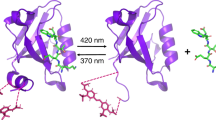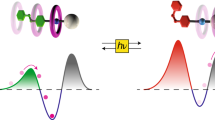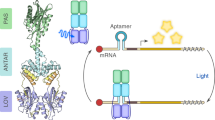Abstract
Organisms must adapt to survive, necessitating regulation of molecular and subcellular processes. Green plant photosynthesis responds to potentially damaging light levels by downregulating the fraction of excitation energy that drives electron transfer. Achieving adaptive, self-regulating behaviour in synthetic molecules is a critical challenge that must be met if the promises of nanotechnology are to be realized1. Here we report a molecular pentad consisting of two light-gathering antennas, a porphyrin electron donor, a fullerene electron acceptor and a photochromic control moiety. At low white-light levels, the molecule undergoes photoinduced electron transfer with a quantum yield of 82%. As the light intensity increases, photoisomerization of the photochrome leads to quenching of the porphyrin excited state, reducing the quantum yield to as low as 27%. This self-regulating molecule modifies its function according to the level of environmental light, mimicking the non-photochemical quenching mechanism2,3,4,5,6,7,8 for photoprotection found in plants.
This is a preview of subscription content, access via your institution
Access options
Subscribe to this journal
Receive 12 print issues and online access
$259.00 per year
only $21.58 per issue
Buy this article
- Purchase on Springer Link
- Instant access to full article PDF
Prices may be subject to local taxes which are calculated during checkout





Similar content being viewed by others
References
Stephanopoulos, N., Solis, E. O. P. & Stephanopoulos, G. Nanoscale process systems engineering: Toward molecular factories, synthetic cells, and adaptive devices. AIChE J. 51, 1858–1869 (2005).
Demmig-Adams, B. & Adams III, W. W. Antioxidants in photosynthesis and human nutrition. Science 298, 2149–2153 (2002).
Horton, P. & Ruban, A. V. Molecular design of the photosystem II light-harvesting antenna: Photosynthesis and photoprotection. J. Exp. Bot. 56, 365–373 (2005).
Holt, N. E. et al. Toward an understanding of the mechanism of nonphotochemical quenching in green plants. Science 307, 433–436 (2005).
Berera, R. et al. A simple artificial light-harvesting dyad as a model for excess energy dissipation in oxygenic photosynthesis. Proc. Natl Acad. Sci. USA 103, 5343–5348 (2006).
Pascal, A. A. et al. Molecular basis of photoprotection and control of photosynthetic light-harvesting. Nature 436, 134–137 (2005).
Ruban, A. V. et al. Identification of a mechanism of photoprotective energy dissipation in higher plants. Nature 450, 575–578 (2007).
Kulheim, C., Ågren, J. & Jansson, S. Rapid regulation of light harvesting and plant fitness in the field. Science 297, 91–93 (2002).
Gust, D., Moore, T. A. & Moore, A. L. Molecular switches controlled by light. Chem. Commun. 2006, 1169–1178 (2006).
Bahr, J. L. et al. Photoswitched singlet energy transfer in a porphyrin–spiropyran dyad. J. Am. Chem. Soc. 123, 7124–7133 (2001).
Guo, X., Zhang, D., Zhou, Y. & Zhu, D. Synthesis and spectral investigations of a new dyad with spiropyran and fluorescein units: Toward information processing at the single molecular level. J. Org. Chem. 68, 5681–5687 (2003).
Irie, M. et al. Organic chemistry: A digital fluorescent molecular photoswitch. Nature 420, 759–760 (2002).
Norsten, T. B. & Branda, N. R. Photoregulation of fluorescence in a porphyrinic dithienylethene photochrome. J. Am. Chem. Soc. 123, 1784–1785 (2001).
Jares-Erijman, E. et al. Imaging quantum dots switched on and off by photochromic fluorescence resonance energy transfer (pcFRET). Mol. Cryst. Liq. Cryst. 430, 257–265 (2005).
Raymo, F. M. & Tomasulo, M. Electron and energy transfer modulation with photochromic switches. Chem. Soc. Rev. 34, 327–336 (2005).
Liddell, P. A. et al. Benzene-templated model systems for photosynthetic antenna–reaction center function. J. Phys. Chem. B 108, 10256–10265 (2004).
Kodis, G. et al. Energy and photoinduced electron transfer in a wheel-shaped artificial photosynthetic antenna–reaction center complex. J. Am. Chem. Soc. 128, 1818–1827 (2006).
Andréasson, J. et al. All-photonic molecular half-adder. J. Am. Chem. Soc. 12, 16259–16265 (2006).
Acknowledgements
This work was supported by the U.S. National Science Foundation (CHE-0352599).
Author information
Authors and Affiliations
Contributions
S.D.S. contributed to the synthesis and spectroscopic study of the molecules. G.K. performed the transient absorption experiments and interpreted them. Y.T. contributed to the synthesis. M.H. carried out electrochemical studies. All authors discussed the results and commented on the manuscript.
Corresponding authors
Supplementary information
Rights and permissions
About this article
Cite this article
Straight, S., Kodis, G., Terazono, Y. et al. Self-regulation of photoinduced electron transfer by a molecular nonlinear transducer. Nature Nanotech 3, 280–283 (2008). https://doi.org/10.1038/nnano.2008.97
Received:
Accepted:
Published:
Issue Date:
DOI: https://doi.org/10.1038/nnano.2008.97
This article is cited by
-
Hypoxia modulation by dual-drug nanoparticles for enhanced synergistic sonodynamic and starvation therapy
Journal of Nanobiotechnology (2021)
-
Coupling carbon nanomaterials with photochromic molecules for the generation of optically responsive materials
Nature Communications (2016)
-
An allosteric photoredox catalyst inspired by photosynthetic machinery
Nature Communications (2015)
-
Natural strategies for photosynthetic light harvesting
Nature Chemical Biology (2014)
-
Evolution of reaction center mimics to systems capable of generating solar fuel
Photosynthesis Research (2014)



